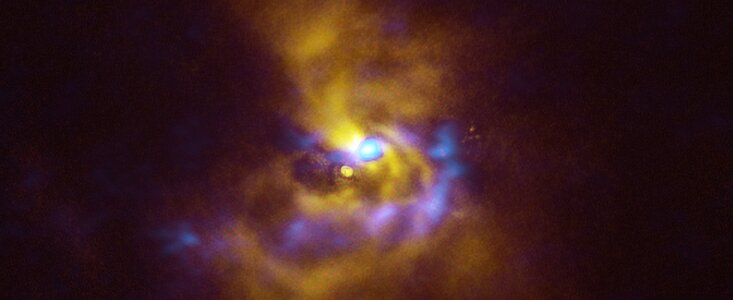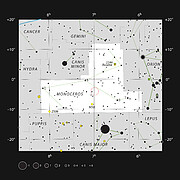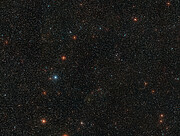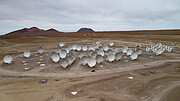Persbericht
Nieuwe foto onthult de geheimen van een planetaire geboorte
25 juli 2023

Een spectaculaire nieuwe opname die vandaag is vrijgegeven door de Europese Zuidelijke Sterrenwacht (ESO) bevat aanwijzingen over hoe planeten ter grootte van Jupiter zouden kunnen ontstaan. Met behulp van ESO’s Very Large Telescope (VLT) en de Atacama Large Millimeter/submillimeter Array (ALMA) hebben onderzoekers in de buurt van een jonge ster grote samenklonteringen van stof ontdekt die tot reuzenplaneten zouden kunnen samensmelten.
‘Deze ontdekking is echt fascinerend, want het betreft de allereerste waarneming van samenklonteringen rond een jonge ster die het potentieel hebben om reuzenplaneten te vormen,’ zegt Alice Zurlo, een onderzoeker aan de Universidad Diego Portales in Chili, die betrokken was bij de waarnemingen.
Het onderzoek is gebaseerd op een fascinerende opname die is verkregen met het Spectro-Polarimetric High-contrast Exoplanet REsearch (SPHERE)-instrument van ESO’s VLT, dat boeiende details laat zien van het materiaal rond de ster V960 Mon. Deze jonge ster bevindt zich op meer dan 5000 lichtjaar afstand in het sterrenbeeld Monoceros (Eenhoorn) en trok de aandacht van astronomen toen hij in 2014 plotseling meer dan twintig keer zo helder werd. SPHERE-waarnemingen die kort na het begin van deze helderheidsuitbarsting werden gedaan, lieten zien dat de materie die om V960 Mon draait, samenkomt in een aantal complexe spiraalarmen die zich uitstrekken over afstanden groter dan ons hele zonnestelsel.
Deze ontdekking bracht astronomen ertoe om archiefwaarnemingen van hetzelfde stersysteem te analyseren die zijn gedaan met ALMA, waarin ESO partner is. De VLT-waarnemingen tasten het oppervlak van het stofrijke materiaal rond de ster af, terwijl ALMA dieper in de structuur ervan kan kijken. ‘Met ALMA werd duidelijk dat de spiraalarmen aan het verbrokkelen zijn, wat resulteert in de vorming van samenklonteringen van planetaire proporties,’ zegt Zurlo.
Astronomen denken dat reuzenplaneten ontstaan door ‘kernaccretie’ – het samenklonteren van stofdeeltjes tot een grote kern – of door ‘gravitationele instabiliteit’ – een proces waarbij grote brokstukken materiaal rond een ster samentrekken tot planetaire bouwstenen. Voor het eerste scenario hebben onderzoekers al eerder bewijs gevonden, maar voor het tweede scenario was nog maar weinig steun.
‘Niemand had ooit een echte waarneming gezien van gravitationele instabiliteit op planetaire schaal – tot nu toe dan’, zegt Philipp Weber, onderzoeker aan de Universiteit van Santiago in Chili en leider van de studie die vandaag in The Astrophysical Journal Letters is gepubliceerd.
‘Onze groep is al meer dan tien jaar op zoek naar tekenen van hoe planeten zich vormen, en we zijn ontzettend blij met deze ongelooflijke ontdekking,’ zegt teamlid Sebastián Pérez van de Universiteit van Santiago in Chili.
ESO-instrumenten zullen astronomen helpen om meer details te onthullen van dit fascinerende planetenstelsel-in-wording, en ESO’s Extremely Large Telescope (ELT) zal daarbij een sleutelrol spelen. De ELT, die momenteel in aanbouw is in de Chileense Atacama-woestijn, zal het stelsel gedetailleerder dan ooit kunnen waarnemen en er cruciale informatie over verzamelen. ‘De ELT zal het mogelijk maken om de chemische complexiteit rond deze klonten te onderzoeken, waardoor we meer te weten komen over de samenstelling van het materiaal waaruit mogelijke planeten worden gevormd,’ concludeert Weber.
Meer informatie
Het team achter dit onderzoek bestaat uit jonge wetenschappers van diverse Chileense universiteiten en instituten, onder de vlag van het Millennium Nucleus on Young Exoplanets and their Moons (YEMS)-onderzoekscentrum, dat wordt gefinancierd door het Chileens Nationale Agentschap voor Onderzoek en Ontwikkeling (ANID) en zijn Millennium Wetenschappelijk Initiatief Programma. De twee faciliteiten die hierbij zijn gebruikt, ALMA en de VLT, staan in de Chileense Atacama-woestijn.
De resultaten van het onderzoek zijn te vinden in een artikel dat in The Astrophysical Journal Lettersverschijnt (doi: 10.3847/2041-8213/ace186).
Het onderzoeksteam bestaat uit P. Weber (Departamento de Física, Universidad de Santiago de Chile, Chili [USACH]; Millennium Nucleus on Young Exoplanets and their Moons, Chili [YEMS]; Center for Interdisciplinary Research in Astrophysics and Space Exploration, Universidad de Santiago de Chile, Chili [CIRAS]), S. Pérez (USACH; YEMS; CIRAS), A. Zurlo (YEMS; Núcleo de Astronomía, Universidad Diego Portales Chile [UDP]; Escuela de Ingeniería Industrial, Universidad Diego Portales, Chili), J. Miley (Joint ALMA Observatory, Chili; National Astronomical Observatory of Japan), A. Hales (National Radio Astronomy Observatory, VS), L. Cieza (YEMS; UDP), D. Principe (MIT Kavli Institute for Astrophysics and Space Research, VS), M. Cárcamo (YEMS; CIRAS; USACH, Faculty of Engineering, Computer Engineering Department, Chili), A. Garufi (INAF, Osservatorio Astrofisico di Arcetri, Italië), Á. Kóspál (Konkoly Observatory, Research Centre for Astronomy and Earth Sciences, Eötvös Loránd Research Network (ELKH), Hongarije; CSFK, MTA Centre of Excellence, Hongarije; ELTE Eötvös Loránd University, Institute of Physics, Hongarije; Max-Planck-Institut für Astronomie, Duitsland), M. Takami (Institute of Astronomy and Astrophysics, Academia Sinica, Taiwan, ROC), J. Kastner (School of Physics & Astronomy, Rochester Institute of Technology, VS), Z. Zhu (Department of Physics and Astronomy, University of Nevada, VS; Nevada Center for Astrophysics, University of Nevada, VS), en J. Williams (Institute for Astronomy, University of Hawai‘i at Manoa, VS).
De Atacama Large Millimeter/submillimeter Array (ALMA), een internationale astronomische faciliteit, is een samenwerkingsverband van ESO, de Amerikaanse National Science Foundation (NSF) en de National Institutes of Natural Sciences (NINS) van Japan, in samenwerking met de Republiek Chili. ALMA wordt gefinancierd door ESO (namens haar lidstaten), door de NSF in samenwerking met de National Research Council of Canada (NRC) en de National Science Council of Taiwan (NSC), en door NINS in samenwerking met de Academia Sinica (AS) in Taiwan en het Korea Astronomy and Space Science Institute (KASI). De bouw en het beheer van ALMA worden geleid door ESO (namens haar lidstaten); door het National Radio Astronomy Observatory (NRAO), dat namens Noord-Amerika wordt bestuurd door de Associated Universities, Inc. (AUI), en namens Oost-Azië door het National Astronomical Observatory of Japan (NAOJ). De overkoepelende leiding en het toezicht op bouw, ingebruikname en beheer van ALMA is in handen van het Joint ALMA Observatory (JAO).
De Europese Zuidelijke Sterrenwacht (ESO) stelt wetenschappers van over de hele wereld in staat om de geheimen van het heelal te ontdekken, ten bate van iedereen. Wij ontwerpen, bouwen en exploiteren observatoria van wereldklasse die door astronomen worden gebruikt om spannende vragen te beantwoorden en de fascinatie voor astronomie te verspreiden, en bevorderen internationale samenwerking op het gebied van de astronomie. ESO, in 1962 opgericht als intergouvernementele organisatie, wordt inmiddels gedragen door 16 lidstaten (België, Denemarken, Duitsland, Finland, Frankrijk, Ierland, Italië, Nederland, Oostenrijk, Polen, Portugal, Spanje, Tsjechië, het Verenigd Koninkrijk, Zweden en Zwitserland) en door het gastland Chili, met Australië als strategische partner. Het hoofdkwartier van de ESO en haar bezoekerscentrum en planetarium, de ESO Supernova, zijn gevestigd nabij München in Duitsland, maar onze telescopen staan opgesteld in de Chileense Atacama-woestijn – een prachtige plek met unieke omstandigheden voor het doen van hemelwaarnemingen. ESO exploiteert drie waarnemingslocaties: La Silla, Paranal en Chajnantor. Op Paranal staan ESO’s Very Large Telescope en Very Large Telescope Interferometer, evenals surveytelescopen zoals VISTA. Ook zal ESO op Paranal de Cherenkov Telescope Array South huisvesten en exploiteren – ’s werelds grootste en gevoeligste observatorium van gammastraling. Samen met internationale partners beheert ESO APEX en ALMA op Chajnantor, twee faciliteiten die de hemel waarnemen in het millimeter- en submillimetergebied. Op Cerro Armazones, nabij Paranal, bouwen wij ‘het grootste oog ter wereld’ – ESO’s Extremely Large Telescope. Vanuit onze kantoren in Santiago, Chili, ondersteunen wij onze activiteiten in het gastland en werken wij samen met Chileense partners en de Chileense samenleving.
Links
- Onderzoeksartikel
- Foto’s van de VLT
- Foto’s van ALMA
- Ontdek meer over ESO’s Extremely Large Telescope
- Voor journalisten: abonneer je op persberichten in je eigen taal
- Voor wetenschappers: heb je een verhaal? Promoot je onderzoek!
Contact
Philipp Weber
University of Santiago
Santiago, Chile
Mobiel: +56966821513 / +4915759366702
E-mail: philipppweber@gmail.com
Alice Zurlo
Universidad Diego Portales
Santiago, Chile
Tel: +56 22138153
E-mail: alice.zurlo@mail.udp.cl
Sebastián Pérez
University of Santiago
Santiago, Chile
Mobiel: +56 9 78776812
E-mail: sebastian.perez.ma@usach.cl
Bárbara Ferreira
ESO Media Manager
Garching bei München, Germany
Tel: +49 89 3200 667
Mobiel: +49 151 241 664 00
E-mail: press@eso.org
Marieke Baan (Perscontact Nederland)
ESO Science Outreach Network
en NOVA Informatie Centrum
Tel: +31(0)20-5257480
E-mail: eson-netherlands@eso.org
Over dit bericht
| Persberichten nr.: | eso2312nl |
| Naam: | V960 Mon |
| Type: | Milky Way : Star : Circumstellar Material : Disk : Protoplanetary |
| Facility: | Atacama Large Millimeter/submillimeter Array, Very Large Telescope |
| Instruments: | SPHERE |
| Science data: | 2023ApJ...952L..17W |
Our use of Cookies
We use cookies that are essential for accessing our websites and using our services. We also use cookies to analyse, measure and improve our websites’ performance, to enable content sharing via social media and to display media content hosted on third-party platforms.
ESO Cookies Policy
The European Organisation for Astronomical Research in the Southern Hemisphere (ESO) is the pre-eminent intergovernmental science and technology organisation in astronomy. It carries out an ambitious programme focused on the design, construction and operation of powerful ground-based observing facilities for astronomy.
This Cookies Policy is intended to provide clarity by outlining the cookies used on the ESO public websites, their functions, the options you have for controlling them, and the ways you can contact us for additional details.
What are cookies?
Cookies are small pieces of data stored on your device by websites you visit. They serve various purposes, such as remembering login credentials and preferences and enhance your browsing experience.
Categories of cookies we use
Essential cookies (always active): These cookies are strictly necessary for the proper functioning of our website. Without these cookies, the website cannot operate correctly, and certain services, such as logging in or accessing secure areas, may not be available; because they are essential for the website’s operation, they cannot be disabled.
Functional Cookies: These cookies enhance your browsing experience by enabling additional features and personalization, such as remembering your preferences and settings. While not strictly necessary for the website to function, they improve usability and convenience; these cookies are only placed if you provide your consent.
Analytics cookies: These cookies collect information about how visitors interact with our website, such as which pages are visited most often and how users navigate the site. This data helps us improve website performance, optimize content, and enhance the user experience; these cookies are only placed if you provide your consent. We use the following analytics cookies.
Matomo Cookies:
This website uses Matomo (formerly Piwik), an open source software which enables the statistical analysis of website visits. Matomo uses cookies (text files) which are saved on your computer and which allow us to analyze how you use our website. The website user information generated by the cookies will only be saved on the servers of our IT Department. We use this information to analyze www.eso.org visits and to prepare reports on website activities. These data will not be disclosed to third parties.
On behalf of ESO, Matomo will use this information for the purpose of evaluating your use of the website, compiling reports on website activity and providing other services relating to website activity and internet usage.
Matomo cookies settings:
Additional Third-party cookies on ESO websites: some of our pages display content from external providers, e.g. YouTube.
Such third-party services are outside of ESO control and may, at any time, change their terms of service, use of cookies, etc.
YouTube: Some videos on the ESO website are embedded from ESO’s official YouTube channel. We have enabled YouTube’s privacy-enhanced mode, meaning that no cookies are set unless the user actively clicks on the video to play it. Additionally, in this mode, YouTube does not store any personally identifiable cookie data for embedded video playbacks. For more details, please refer to YouTube’s embedding videos information page.
Cookies can also be classified based on the following elements.
Regarding the domain, there are:
- First-party cookies, set by the website you are currently visiting. They are stored by the same domain that you are browsing and are used to enhance your experience on that site;
- Third-party cookies, set by a domain other than the one you are currently visiting.
As for their duration, cookies can be:
- Browser-session cookies, which are deleted when the user closes the browser;
- Stored cookies, which stay on the user's device for a predetermined period of time.
How to manage cookies
Cookie settings: You can modify your cookie choices for the ESO webpages at any time by clicking on the link Cookie settings at the bottom of any page.
In your browser: If you wish to delete cookies or instruct your browser to delete or block cookies by default, please visit the help pages of your browser:
Please be aware that if you delete or decline cookies, certain functionalities of our website may be not be available and your browsing experience may be affected.
You can set most browsers to prevent any cookies being placed on your device, but you may then have to manually adjust some preferences every time you visit a site/page. And some services and functionalities may not work properly at all (e.g. profile logging-in, shop check out).
Updates to the ESO Cookies Policy
The ESO Cookies Policy may be subject to future updates, which will be made available on this page.
Additional information
For any queries related to cookies, please contact: pdprATesoDOTorg.
As ESO public webpages are managed by our Department of Communication, your questions will be dealt with the support of the said Department.







